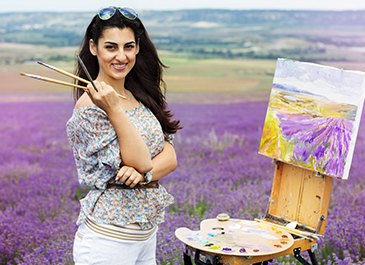As a practicing Art Therapist, I find my biggest challenge is convincing people that they do not need to be talented artists to enjoy the benefits of Art Therapy.
Do you recall stepping up to an easel when you were in kindergarten? There were paint jars and brushes and you just began without worrying about what it would be. You weren’t concerned about it being perfect or if it would be judged. You didn’t care if the person you painted had green hair and stood towering over the houses. You were free of selfconsciousness and had no inner critic to block your spontaneous expression.
In my Art Therapy studio, I offer clients the same experience. There are colourful jars of paints, brushes and paper. There is a lot of room for drips and splatters. There is no room for perfection.
However, it is not so easy for adults to let go of their now well-developed inner critic, or their fear of being judged. As our rational, ego-driven left brains tend to dominate, the ability to surrender to the more intuitive right brain gets lost in our daily lives. We so easily block ourselves from spontaneity and playfulness. Our fear of not being perfect can be paralyzing.
In order to facilitate spontaneous expression, I often begin a session with a short meditation. By relaxing and being mindful of one’s breathing, a client is brought into deeper bodyawareness, is more present in the moment, and less “in their head”. I invite the client to simply begin by letting the first colour “choose them”. Often, that’s all it takes. The painting begins to flow. If self-criticism pops up, then I may offer up a question: “If it didn’t matter what the painting looked like, what would you paint next?”
The results are often surprising for the painter: “I have no idea what this is supposed to be.” So we sit and talk about the experience and the painting. I ask questions which may lead to a deeper exploration of feelings which, in turn, may lead to insights and clarity about an issue.
Other questions may arise: “How can I change this problem?” I might respond: “What would it look like if this problem were gone?” and I would invite my client to meditate on this question and to paint again. This kind of painting is very powerful: by embodying and expressing the absence of pain (emotional, physical), a client may begin to take control of the healing process. Spontaneous painting is a holistic practice: it is a physical, emotional and often spiritual act. All three come together at once to produce an image and experience that is driven by our instinctive need to heal and find balance.
I am always struck by the sense of openness and energy that clients can feel at the end of a session. Recently, a client described it like this: “I feel relaxed yet energized . . . my body feels lighter and has more room inside.” Another self-proclaimed “non-artist” said “This really isn’t about being an artist or making beautiful art. It’s about taking what’s beneath the surface and making it visual and more real . . . it’s a release.”
Art Therapy is a gentle yet powerful mode of healing many issues. If you are ready to let go of perfection, play with paint, laugh, cry and get to know yourself better, then Art Therapy may be for you. To learn more, join Stephanie for an interactive seminar- see below for details.
Stephanie Harper is a Registered Art Therapist, practicing at Alchemy & Elixir Health Group in Vancouver # 320-1026 Davie St. For more information visit our website at: www.alchemyelixir.com. Appointments can be booked at 778-988-1312 or by email stephanie@alchemyelixir.com

